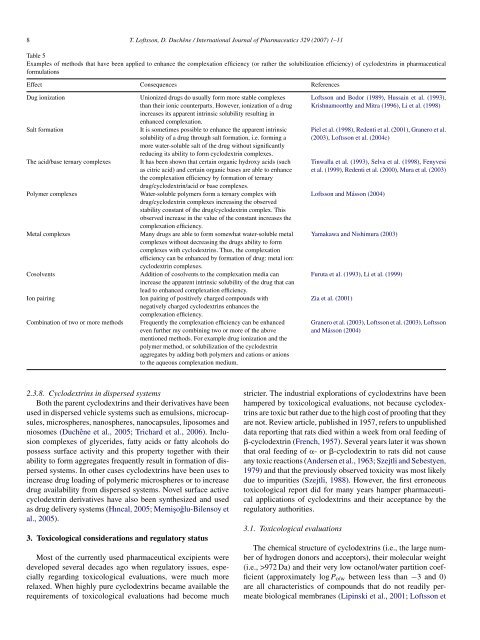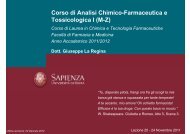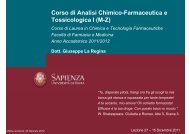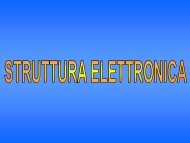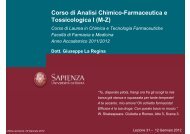Cyclodextrins and their pharmaceutical applications - C.T.F.
Cyclodextrins and their pharmaceutical applications - C.T.F.
Cyclodextrins and their pharmaceutical applications - C.T.F.
You also want an ePaper? Increase the reach of your titles
YUMPU automatically turns print PDFs into web optimized ePapers that Google loves.
8 T. Loftsson, D. Duchêne / International Journal of Pharmaceutics 329 (2007) 1–11<br />
Table 5<br />
Examples of methods that have been applied to enhance the complexation efficiency (or rather the solubilization efficiency) of cyclodextrins in <strong>pharmaceutical</strong><br />
formulations<br />
Effect Consequences References<br />
Dug ionization Unionized drugs do usually form more stable complexes<br />
than <strong>their</strong> ionic counterparts. However, ionization of a drug<br />
increases its apparent intrinsic solubility resulting in<br />
enhanced complexation.<br />
Salt formation It is sometimes possible to enhance the apparent intrinsic<br />
solubility of a drug through salt formation, i.e. forming a<br />
more water-soluble salt of the drug without significantly<br />
reducing its ability to form cyclodextrin complexes.<br />
The acid/base ternary complexes It has been shown that certain organic hydroxy acids (such<br />
as citric acid) <strong>and</strong> certain organic bases are able to enhance<br />
the complexation efficiency by formation of ternary<br />
drug/cyclodextrin/acid or base complexes.<br />
Polymer complexes Water-soluble polymers form a ternary complex with<br />
drug/cyclodextrin complexes increasing the observed<br />
stability constant of the drug/cyclodextrin complex. This<br />
observed increase in the value of the constant increases the<br />
complexation efficiency.<br />
Metal complexes Many drugs are able to form somewhat water-soluble metal<br />
complexes without decreasing the drugs ability to form<br />
complexes with cyclodextrins. Thus, the complexation<br />
efficiency can be enhanced by formation of drug: metal ion:<br />
cyclodextrin complexes.<br />
Cosolvents Addition of cosolvents to the complexation media can<br />
increase the apparent intrinsic solubility of the drug that can<br />
lead to enhanced complexation efficiency.<br />
Ion pairing Ion pairing of positively charged compounds with<br />
negatively charged cyclodextrins enhances the<br />
complexation efficiency.<br />
Combination of two or more methods Frequently the complexation efficiency can be enhanced<br />
even further my combining two or more of the above<br />
mentioned methods. For example drug ionization <strong>and</strong> the<br />
polymer method, or solubilization of the cyclodextrin<br />
aggregates by adding both polymers <strong>and</strong> cations or anions<br />
to the aqueous complexation medium.<br />
2.3.8. <strong>Cyclodextrins</strong> in dispersed systems<br />
Both the parent cyclodextrins <strong>and</strong> <strong>their</strong> derivatives have been<br />
used in dispersed vehicle systems such as emulsions, microcapsules,<br />
microspheres, nanospheres, nanocapsules, liposomes <strong>and</strong><br />
niosomes (Duchêne et al., 2005; Trichard et al., 2006). Inclusion<br />
complexes of glycerides, fatty acids or fatty alcohols do<br />
possess surface activity <strong>and</strong> this property together with <strong>their</strong><br />
ability to form aggregates frequently result in formation of dispersed<br />
systems. In other cases cyclodextrins have been uses to<br />
increase drug loading of polymeric microspheres or to increase<br />
drug availability from dispersed systems. Novel surface active<br />
cyclodextrin derivatives have also been synthesized <strong>and</strong> used<br />
as drug delivery systems (Hıncal, 2005; Memis¸o˘glu-Bilensoy et<br />
al., 2005).<br />
3. Toxicological considerations <strong>and</strong> regulatory status<br />
Most of the currently used <strong>pharmaceutical</strong> excipients were<br />
developed several decades ago when regulatory issues, especially<br />
regarding toxicological evaluations, were much more<br />
relaxed. When highly pure cyclodextrins became available the<br />
requirements of toxicological evaluations had become much<br />
Loftsson <strong>and</strong> Bodor (1989), Hussain et al. (1993),<br />
Krishnamoorthy <strong>and</strong> Mitra (1996), Li et al. (1998)<br />
Piel et al. (1998), Redenti et al. (2001), Granero et al.<br />
(2003), Loftsson et al. (2004c)<br />
Tinwalla et al. (1993), Selva et al. (1998), Fenyvesi<br />
et al. (1999), Redenti et al. (2000), Mura et al. (2003)<br />
Loftsson <strong>and</strong> Másson (2004)<br />
Yamakawa <strong>and</strong> Nishimura (2003)<br />
Furuta et al. (1993), Li et al. (1999)<br />
Zia et al. (2001)<br />
Granero et al. (2003), Loftsson et al. (2003), Loftsson<br />
<strong>and</strong> Másson (2004)<br />
stricter. The industrial explorations of cyclodextrins have been<br />
hampered by toxicological evaluations, not because cyclodextrins<br />
are toxic but rather due to the high cost of proofing that they<br />
are not. Review article, published in 1957, refers to unpublished<br />
data reporting that rats died within a week from oral feeding of<br />
�-cyclodextrin (French, 1957). Several years later it was shown<br />
that oral feeding of �- or�-cyclodextrin to rats did not cause<br />
any toxic reactions (Andersen et al., 1963; Szejtli <strong>and</strong> Sebestyen,<br />
1979) <strong>and</strong> that the previously observed toxicity was most likely<br />
due to impurities (Szejtli, 1988). However, the first erroneous<br />
toxicological report did for many years hamper <strong>pharmaceutical</strong><br />
<strong>applications</strong> of cyclodextrins <strong>and</strong> <strong>their</strong> acceptance by the<br />
regulatory authorities.<br />
3.1. Toxicological evaluations<br />
The chemical structure of cyclodextrins (i.e., the large number<br />
of hydrogen donors <strong>and</strong> acceptors), <strong>their</strong> molecular weight<br />
(i.e., >972 Da) <strong>and</strong> <strong>their</strong> very low octanol/water partition coefficient<br />
(approximately log Po/w between less than −3 <strong>and</strong> 0)<br />
are all characteristics of compounds that do not readily permeate<br />
biological membranes (Lipinski et al., 2001; Loftsson et


